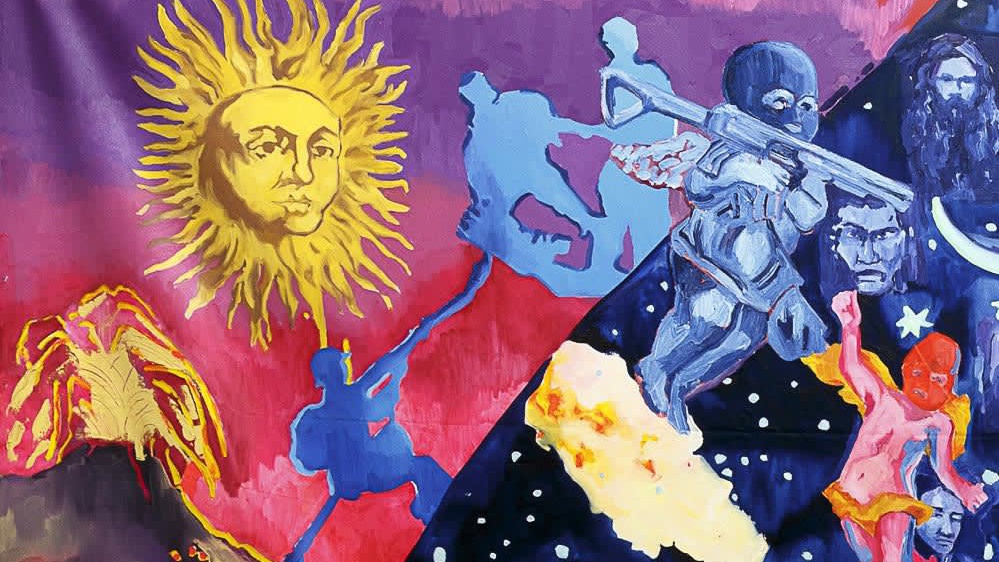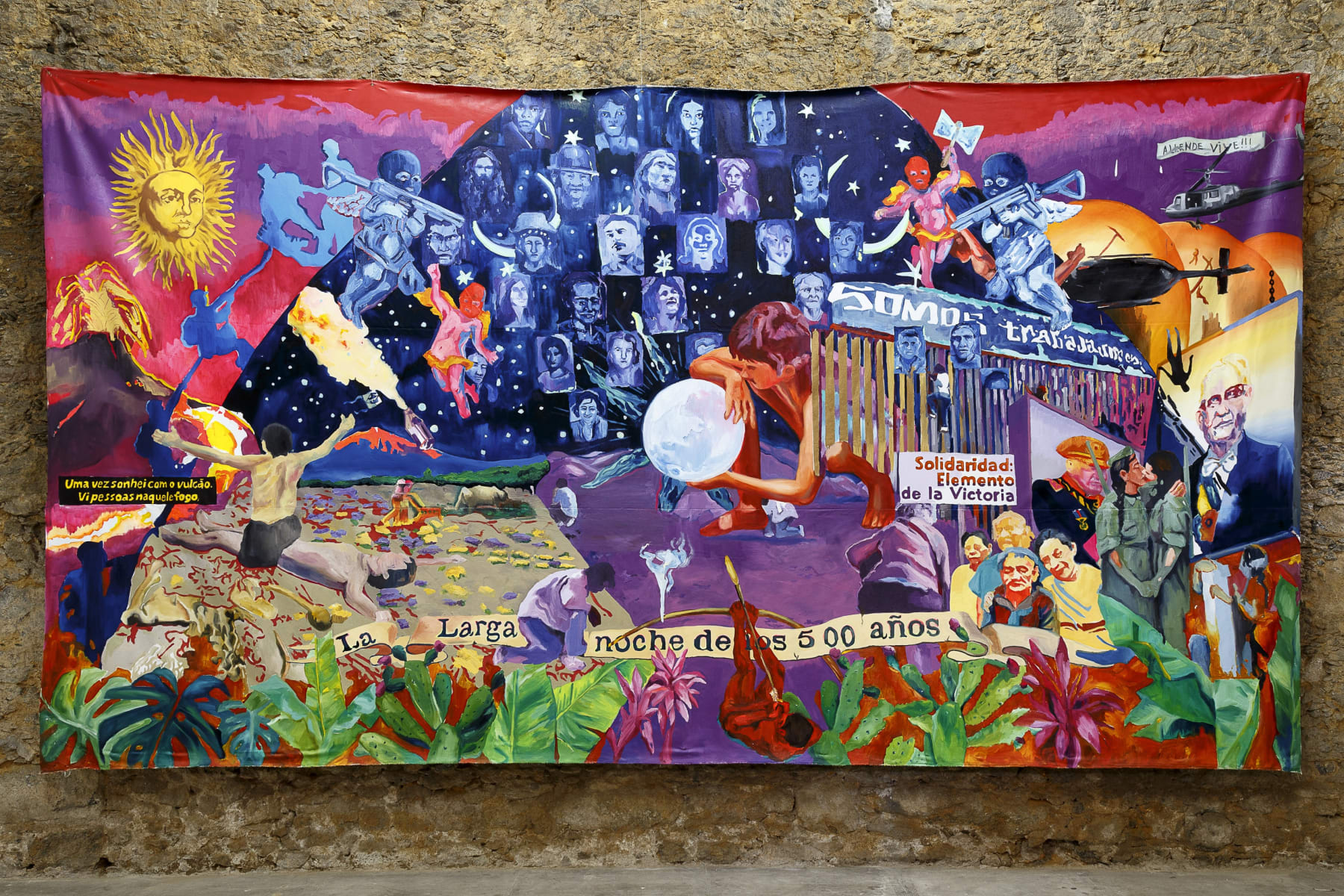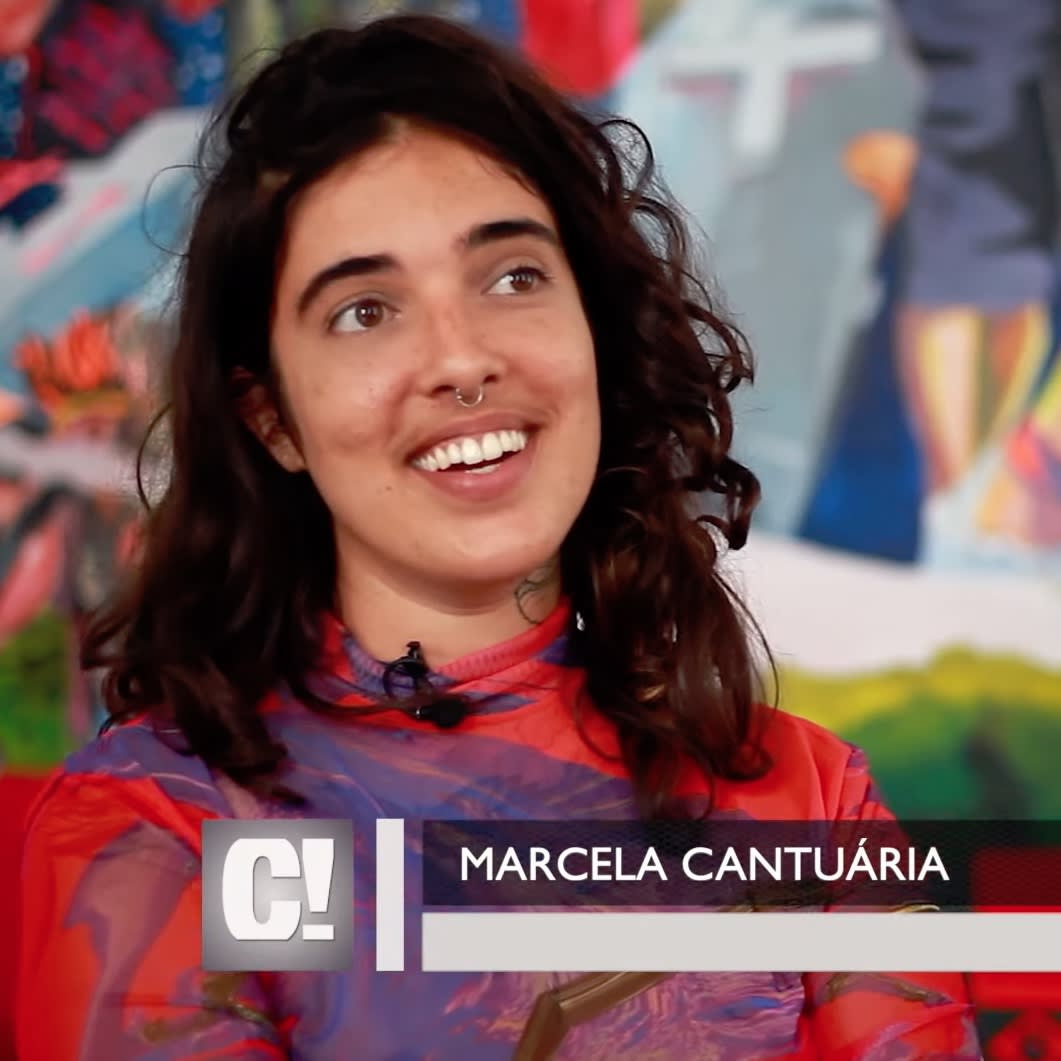Marcela Cantuária | La Larga Noche de los 500 años

In her work, Marcela Cantuária appropriates images from different backgrounds, elaborating a counter-narrative, with the aim of highlighting the flourishing of another future. Her approach highlights symbols that start from the effervescence of themes that involve multiple perspectives, weaving approximations between social spheres, political associations and oneiric wishes. Her works establish contact points between temporalities, the imaginary about female political protagonism and the symbolic disputes about the intensification of the struggle between social classes. Although there are many methodologies that help in approaching and in the reflective elaboration surrounding pictorial language, guided by epistemic interests, we will adopt an approach to the sociology of images as proposed by the Bolivian sociologist and Aymara descendant activist, Silvia Rivera Cusicanqui (1949), who proposes a theoretical, aesthetic and ethical practice that does not recognize boundaries between artistic creation and conceptual and political reflection [1]. The inheritance of hegemonic conducts and the configurations of power systems are themes present in the works of the exhibition La larga noche de los 500 años (The great night of 500 years). In this sense, we highlight the research undertaken by the artist, beyond a compositional proposal, formal or aesthetic, viewing her compositions as the result of a conceptual elaboration in line with the political imagination.
Cantuária refuses an identification with the official narrative and opts for a contrarian reading, pictorially instrumentalizing insurgent utopian images / monuments, integrated into the history of social exclusion, labor exploitation and environmental degradation. Issues related to the exploitation of natural resources emerge with the utmost urgency, given the expansion of parasitic policies towards planetary natural resources. From ancient times the stars served as a geographical and ethical guide. Parallels can be drawn between the interests of the artist and researcher Victor Wallis, who states: the only habitable future is ecosocialist [2], recognizing that "the most radical expressions of environmental awareness" [3] originate from the peoples of the global South. Thus, peasant and indigenous leaders become the target of distinct processes of annihilation and silencing, through the persecution of popular struggles opposed to the extractive interests of international conglomerates.
La larga noche de los 500 años (2019) overlaps distinct layers of historical repertoire, a painting of ethical aspirations to overcome prevailing oppressions. The basis of her composition is an engraving in Camille Flammarion's L'Atmosphere: Météorologie Populaire (1888), an illustration of a medieval missionary who affirms the existence of a place where heaven and earth meet. This engraving is hybridized to the Andean concept of pachakuti, a Quechua and Aymara word where pacha means time, space or world, and kuti means agitation, revolution. An idea that advocates a rebalancing of the world through catastrophic events or renewal.
In Pachakuti: The Historical Horizons of Internal Colonialism (1991), Cusicanqui understands that part of the nation considers reform as just a power struggle between political parties, thus going through a moment of blindness that reveals dark aspects of our present day. In this context of fierce dispute, Cusicanqui warns that "perhaps the time of war is not far off" (4). This is a central element in the artist's research, which opens up multiple possibilities of access to various systems and narratives. By breaking with chronological linearity, Cantuária abandons the limitations of classical physics, offering a perspective based on nonlinear simultaneities. By doing this, she embeds herself into a long tradition of artists who have been able to perceive the painful psychic fracture that colonial experience introduces in the form of social silence [5]. In La larga noche de los 500 años, a constellation of signs and portraits tear the sky apart, claiming the memory of combatants, thus creating a kind of pantheon of the Latin American insurgency. Two other works of the exhibition highlight the figures of Berta Cáceres, a Honduran environmental activist and Lúcia de Souza "Sônia", a Brazilian member of the Araguaia Guerrilla.
According to ancient indigenous beliefs, after the long night of 500 years, beginning with the arrival of Europeans on the continent, the world would undergo a reordering in which a new order will emerge, the dawn of a beneficial and glorious time for the indigenous people. Cantuária proposes Jean-Baptiste Debret's Caboclo as a Pachakuti paladin aiming at the moon, announcing the arrival of a social and mystical reordering. In this sense, it is worth considering the title of the work that also evokes the speech of the Clandestine Revolutionary Indigenous Committee of the Zapatista army delivered in 1994. No wonder that the Atacama Desert appears in the composition, simultaneously split into two distinct times, represented as one of the driest places in the world that functioned as a place to hide the dictatorship violence and also the scene of the rare desert flowering known as "Atacama's miracle ". This place, previously immersed in the dust of the past, is disordered by this unpredictable natural phenomenon, transforming itself into sublime flower gardens. The Araguaia guerrillas, VPR, ALN, KPD, Polop, the Mujeres del Cuá and the Mujeres de Calama are presences that have subverted the logic of authoritarianism and subjugation. So, in the light of our current political context, La larga noche de los 500 años emerges from the urgency of articulating a poetics of memory, manipulating symbols as a political strategy, in favor of the emancipation of the imaginary.
Aldones Nino, 2019
[1] Originally: "una práctica teórica, estética y ética que no reconozca fronteras entre la creación artística y la reflexión conceptual y política". Rivera Cusicanqui, Silvia. Sociología de la imagen: ensayos . - 1a ed. - Ciudad Autónoma de Buenos Aires: Tinta Limón, 2015, p.27.
[2] Victor Wallis. Red-Green Revolution: The Politics and Technology of Ecosocialism. Political Animal Press: Chicago, 2018.
[3] Originally: " the most radical expressions of environmental awareness". Cited by Cy Gonick in "Exploring Ecosocialism as a System of Thought", Canadian Dimension, Vol. 44 No. 5, Sept/Oct 2010.
[4] Originally: "Perhaps the time of war is not far off". In: Silvia Rivera Cusicanqui, Pachakuti: The historical horizons of internal colonialism, 1991.
[5] Originally: "que fueron capaces de percibir la dolorosa fractura psíquica que introduce la experiencia colonial, bajo la forma del silencio social". Rivera Cusicanqui, Silvia. Sociología de la imagen: ensayos . - 1a ed. - Ciudad Autónoma de Buenos Aires: Tinta Limón, 2015, p.82.







